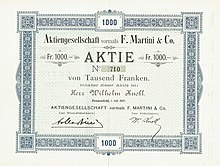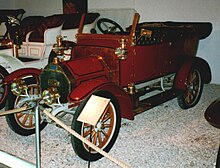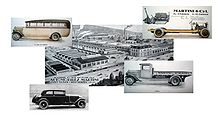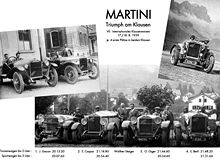Martini (automobile factory)
Martini (1897–1934) was the most important and successful Swiss passenger car factory. Around 3,500 vehicles were produced in the 37 years of its existence.
The company emerged from the machine factory F. Martini & Co. founded by the Swiss designer and inventor Friedrich von Martini in 1860 in Frauenfeld , Canton Thurgau , a company that initially produced bookbinding and textile machines, from 1869 mainly guns (Martini-Henry- Nozzles) . On July 1, 1897, the company was registered as a stock corporation formerly F. Martini & Co.
history
Adolph and Max von Martini, the sons of Friedrich von Martini, brought passenger cars to the market in quick succession from 1897 onwards. Their first own model, an open motor vehicle with a two-cylinder rear engine, which was still very reminiscent of Carl Benz designs , was improved in 1898. Type 3 with a front engine followed in 1899. In 1901 they developed Type 4, a 10 hp car that also served as the basis for their first truck. In 1902 they had two new V-four-cylinders with 10 and 16 hp in their range and in the same year they entered into a license agreement with the French manufacturer Rochet-Schneider , whose 14/18 hp model based on the Mercedes-Simplex they reproduced. The strong sales of these cars encouraged the expansion of production capacities.
For this purpose, a modern factory was built in Saint-Blaise near Neuchâtel in 1903 . For the rapidly growing workforce, a settlement of two-story houses with gardens was built near the plant, which is still inhabited today as the listed "Cité Martini" . The engines continued to be manufactured in Frauenfeld until 1917.
New plant in western Switzerland
Car races and other sporting competitions played an important role at Martini in marketing its own products. The martinis, which are regarded as fast and persistent, achieved numerous successes and made the brand known abroad. In 1905 there was already a considerable range of models on offer: 4-cylinder machines with strengths of 16, 20, 25 and 40 hp in several body variants, from a pure chassis to fully-bodied open Phaetons and half or fully closed sedans. They not only produced for the limited domestic market, but also exported to France, England, and even as far as North and South America, New Zealand, Canada, Russia and Egypt. With the English importer HHP Deasy an investor could be won who made publicity for the brand through sensational campaigns.
Deasy undertook several record runs, including a ride on cogwheel train tracks up the 2045 m high Rochers-de-Naye near Montreux , a distance of at least eleven kilometers with a 23% gradient in places, which his 14 HP Martini covered faster than the mountain railway itself. Another promotion consisted of a reliability run 3,000 km across the Alps, over 34 passes in France, Italy and Switzerland and a total difference in altitude of 37,000 meters.
In a bet against Rolls-Royce ("Battle of the Cylinders" - 4,000 miles / 4-cylinder Martini against six-cylinder Rolls-Royce), however, Deasy lost.
First crisis
The year 1910 brought the first losses. Although a total of 260 cars were produced and sold through their own sales companies in Paris, Berlin, London, Madrid, Lisbon and New York, they still earned little, as they were still produced by laborious manual labor. Then there was the surprising bankruptcy of their own house bank. Constantly on the lookout for new capital, Martini renamed several times, fell into British (Martini Automobile Co. Ltd.), French, then back into Swiss hands, was finally converted into Neue Martini Automobilgesellschaft, while Adolph and Max von Martini already owned the company had left.
Until 1914 a slightly streamlined model series was built (including three different passenger cars, two trucks and a small bus). Again, modest profits were made. During the First World War , the order situation improved considerably, and Martini's annual production peaked in 1917 with approximately 350 vehicles.
In 1919 the company got into violent turbulence again, as large-scale manufacturers such as Fiat , Ford or Citroën were offering much cheaper. In the meantime Martini had neither succeeded in developing interesting new products nor in rationalizing its production methods. Until 1925 they stayed afloat with a single model, the TF touring car , an only slightly modified variant of the old 18/24 hp four-cylinder engine from 1913. While most foreign competitors already had twice as strong, much faster and completely bodied Six-cylinder offered at prices of 14,000 francs, Martini demanded 17,000 francs for the chassis of its outdated four-cylinder version alone. The end of the renowned brand seemed already sealed.
Steiger martini
A surprising turn came in 1924 when the brothers Walther and Robert Steiger succeeded in taking over the majority of the shares in Martini. Both came from the family of Swiss textile industrialists based in Ulm (Steiger & Deschler) and had not only capital but also experience in automobile construction. Walther Steiger , who had been manufacturing highly regarded passenger cars in Burgrieden in Württemberg since 1920, took over technical management at Martini.
In 1926, the newly designed Martini-Six model, type FU, was presented at the Geneva Motor Show , a comfortable touring car with a 3.1-liter six-cylinder engine that developed 70 hp (51 kW). The large, reliable touring limousine has a top speed of over 100 km / h and has an electric starter and a vacuum brake aid that acts on all four wheels, as well as a vacuum fuel delivery system.
As early as 1927 Martini presented in the types FUG and FUS a new 4.4-liter six-cylinder engine with Zenith double carburetor, central lubrication and high-speed gearbox that developed between 90 and 100 hp (66 and 73 kW) and even the heavy Pullman versions Accelerated to up to 130 km / h. In addition to coupés and convertibles, spacious, four- to six-seater sedans and landaulets were offered in various designs. Most of these luxuriously equipped passenger cars were bodied by Carrosserie Georges Gangloff in Geneva. With the same engine, on a longer, reinforced base, a small series of trucks and dump trucks, delivery vans and taxis, ambulances and buses were also manufactured.
export
In 1928 Martini founded a sales office for Germany in Munich , where the Martini-Six was offered as the 17/100 PS Steiger Martini , using the good name that the Steiger automobiles had acquired. The ibex from Steiger's own family coat of arms served as the hood ornament.
Motorsport
After years of break, the company devoted itself again to the development and maintenance of special racing versions. Factory and private drivers took part in numerous car races with high-performance, fast touring cars and specially manufactured roadster variants.
Well-known names such as Monard, Gacon, Caspar, Giger and Berli repeatedly won first places for the Swiss brand against strong international competition. In 1929, four martinis won the International Klausen Race , the toughest mountain test in Europe at the time, in an almost sensational way .
Gradual end
Despite great efforts, the expensive production never reached profitable regions and the sales targets were not achieved. The then rather car-hostile laws of Switzerland, increasing competitive pressure from abroad and the effects of the global economic crisis contributed to this. The attempt to achieve profitability with the German Wanderer model W11 (Martini KM, 6 cylinder, 50 hp), manufactured under license from 1930 to 1932, also failed. The project of an inexpensive, modern front-wheel drive vehicle was already stuck in the planning phase for financial reasons.
From 1932 to 1934, a greatly reduced workforce continued to build a few dozen of the redesigned, large 4.4-liter sedans (now as Martini NF). With an output of 95 hp, a synchronized 4-speed gearbox, low-frame construction, Lockheed brakes and hydraulic shock absorbers, the NF represented "a modern and luxurious vehicle which, thanks to its excellent quality, is without a doubt one of the world's top class". But the company could not save this model either. On June 12, 1934, the factory gates were closed forever.
Several excellently preserved Martini cars that have remained in museums and private collections bear witness to the high standard of this once famous Swiss brand.
The trademark rights were taken over in 1990 by the entrepreneur Peter EM Schudel from Müller-Martini-Holding and registered in the Institute for Intellectual Property, Bern, for vehicles on land, in the water and in the air. From 2002 to 2004 ATV / Quads of the "Martini" brand were assembled in Birmensdorf and sold worldwide. There are efforts to revive the brand with an eco-car.
The main models
| Type | construction time | cylinder | Displacement | power | Vmax |
|---|---|---|---|---|---|
| Martini 20/24 HP | 1903-1905 | 4 V | 4712 cc | 24 HP (17 kW) | 50 km / h |
| Martini GA | 1912 | 4th | 2412 cc | 12 HP (9 kW) | 60 km / h |
| Martini TF | 1919-1925 | 4 in a row | 3815 cc | 35–45 hp (26–33 kW) | 90 km / h |
| Martini FU / FUN | 1927-1931 | 6 in a row | 3097 cc | 55–70 hp (40–51 kW) | 100 km / h |
| Martini FUG / FUS / FN | 1927-1931 | 6 in a row | 4379 cm³ | 70–90 hp (51–66 kW) | 120 km / h |
| Martini KM | 1930-1932 | 6 in a row | 2540 cc | 50 HP (37 kW) | 100 km / h |
| Martini NF | 1932-1934 | 6 in a row | 4379 cm³ | 95-100 PS (70-73 kW) | 130 km / h |
literature
- Hans Heinrich von Fersen, u. a .: Classic cars 1919-1939 , Cologne 1994. ISBN 3-8228-8944-X .
- Raynald G. Friedli: Automobiles Martini - St.Blaise (Suisse) , St-Blaise NE, 1993 (French).
- Ferdinand Hediger: Oldtimer - Interesting automobiles from 1885-1939 , 3rd edition Bern 1982. ISBN 3-444-50134-X .
- Ferdinand Hediger: Martini - The best Mountain Climber in Automobile Quarterly , Vol.m 42 No. 1, 2002 pp. 28-41 (English).
- Ernest Schmid: Swiss cars. Swiss automobile construction from 1868 to today , 2nd edition Lausanne 1978.
- Ernest Schmid: Musée de l'automobile , Martigny 1988 (French).
Web links
- Captain Deasy's Daring Drive (fr, PDF file; 197 kB)
- Klausenrennen Ranking 1929. klausenrennen.com, accessed on April 29, 2013 .
- International Klausen race 1929. Chiron's new Klausen record 16: 42.4. In: www-lenya.nzz.ch. Archived from the original on August 13, 2007 ; Retrieved April 29, 2013 .
- Walther Steiger / Martini - Further future in Switzerland. steiger-burgrieden.de, accessed on April 29, 2013 .
- Museum in Martigny , shows u. a. five martinis.
Individual evidence
- ^ Ferdinand Hediger: Oldtimer - Interesting automobiles from 1885-1939 , 3rd edition, Bern 1982. ISBN 3-444-50134-X , p. 70.
- ^ Ernest Schmid: Swiss cars. Swiss automobile construction from 1868 to today , 2nd edition, Lausanne 1978, p. 116.
- ^ Ferdinand Hediger: Martini - The best Mountain Climber in Automobile Quarterly , Vol. 42 No. 1, 2002, p. 31.
- ↑ Ernest Schmid: Musée de l'automobile , Martigny 1988, p. 171.
- ^ Ernest Schmid: Swiss cars. Swiss automobile construction from 1868 to today , 2nd edition Lausanne 1978, p. 109. HHP Deasy's rail journey was captured by two cameramen from the British Mutoscope & Biograph Company and is listed as "Captain Deasy's Daring Drive" (70 mm / GB 1903) in the National Film & Television Archives in London.
- ^ Ernest Schmid: Musée de l'automobile , Martigny 1988, p. 175.
- ↑ Ferdinand Hediger: Martini - The best Mountain Climber in Automobile Quarterly , Vol. 42 No. 1, 2002, p. 36.
- ↑ Ernest Schmid: Musée de l'automobile , Martigny 1988, p. 176
- ↑ a b Ferdinand Hediger: Martini - The best Mountain Climber in Automobile Quarterly , Vol. 42 No. 1, 2002, p. 40.
- ↑ Hans Heinrich von Fersen, u. a .: Classic cars 1919-1939 , Cologne 1994. ISBN 3-8228-8944-X , p. 243. The German brochure advertised an open Martini Tourer photographed in Neuchâtel , which - with "Steiger" lettering on the radiator - in front of a background with the Ulm Minster .
- ↑ a b Hans Heinrich von Fersen, u. a .: Classic cars 1919-1939 , Cologne 1994. ISBN 3-8228-8944-X , p. 244.













